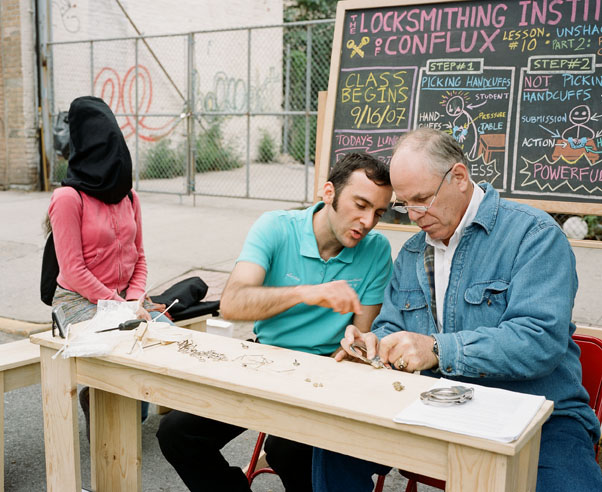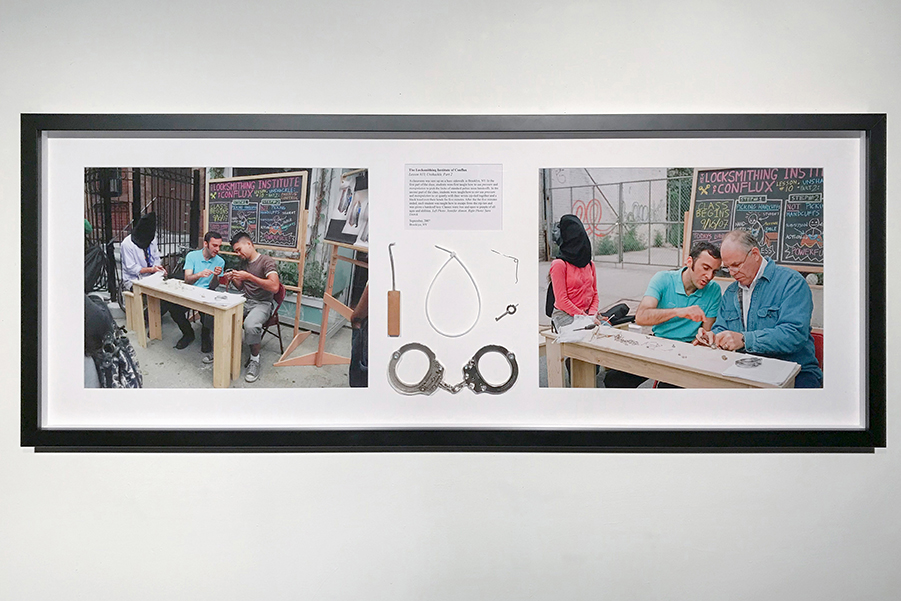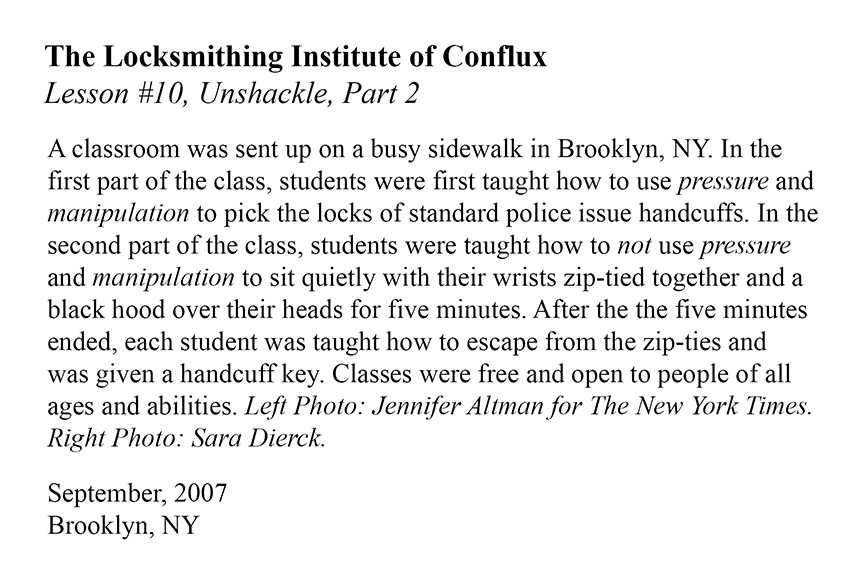 Above: Photo by Jennifer Altman for The New York Times
Above: Photo by Jennifer Altman for The New York Times
The Locksmithing Institute of Conflux, Brooklyn, NY, 2007
In the first part of Lesson #10 students were shown how to get out of standard police issue handcuffs. In the second part of the class students were given the opportunity to choose to willfully submit to restraints by having a black hood placed over their heads and allowing their wrists to be zip-tied together for 5 minutes. After the 5 minutes were over they were shown how to liberate themselves from the zip-ties. Students were encouraged to compare the sensations that arose while they were trying to force their way out of the handcuffs as opposed to what it felt like to willfully decide to not get out of the restraints while having the hood over their heads. The instructor further reminded each student that the feelings that manifested while they were having both of these new experiences were derived from inside of themselves and not from the situation that they were placed in. Each student that completed the class was given a key that will open up most handcuffs in the United States. Special thanks to Sara Dierck for taking photos of the project. Please read the lesson plan bellow for a more in depth description:
The Locksmithing Institute of Conflux
Lesson #10: Unshackle, Part #2: Passive Control
In Lesson #10 of The Locksmithing Institute of Conflux students will be given the opportunity to experience what it is like to submit to and liberate themselves from handcuffs and plastic zip-ties. This will be achieved through an examination of pressure, manipulation, power, action and submission and will include lessons in lock picking, bound escape maneuvers, and passive control.
The normal tactic used to pick a lock consists of two actions. First, one must apply some rotational pressure to the lock cylinder. This will bind the spring-loaded devices inside of the lock into a fixed position. Second, one must use a pick to manipulate those spring-loaded devices into their correct positions. When all is aligned the lock will turn.
Pressure: “The action of pressing painfully upon the sensations or feelings: the condition of being painfully pressed in body or mind; the weight or burden of pain, grief, trouble, poverty, etc.; affliction, oppression,” 1382 AD. (Oxford English Dictionary).
Manipulation: “The action or an act of manipulating something; handling; dexterity. Also (occas.): the making of hand motions,” 1801 AD. “The action or an act of managing or directing a person, etc., esp. in a skillful manner; the excercise of subtle, underhand, or devious influence or control over a person, organization, etc.; interference, tampering,” 1828 AD. (Oxford English Dictionary).
It is not without coincidence that pressure and manipulation are the normal tactics used to pick a lock. These notions are the tools of a person who feels pressed by the process of living and thus views the world as a situation that must be coerced or orchestrated into submission through manipulation. The use of these particular words in conjunction with this process places locks into their most commonly viewed position as a shielded device that deflects the energy of a forced entry or incorrect key. However a lock does not in fact inhibit a persons attempt to break or pick it. In actuality it takes that energy, absorbs it, spreads it out and then renders it impotent. At their core, locks are nothing more than passive vessels for the absorption of energy.
Locks are a creation of people and people are, of course, clever but hardly original. We have survived by observing that which surrounds us and adapting those disparate materials and ideas together to serve a new purpose. The question then becomes: What did we observe when we were first inspired to create a lock? I submit that it was in fact “ourselves.” Through pressure and manipulation we attempt to force ourselves into an understanding of the world that surrounds us. Like attempting to pick a lock, we try to “figure it out”. We at The Locksmithing Institute of Conflux have found that locks do not confine us to certain sections of space and deny our access to others. It would seem that only our perception is capable of achieving this incredible feat of shackling and just as many wise people have already discovered, we are only captive if we choose to perceive ourselves as captive. Considering these things one might ask if there is yet another way to pick a lock if not through “pressure and manipulation.”
Picking locks is an attempt to exert control over something that we think has power over us. Simply put: a lock inhibits our ability to move about the world, therefore, it has the power to control us.
We cannot control the things that happen to us. As the universe unfolds, all of the events that we witness cause us to react in certain ways. If one feels that they cannot control the way that they react to certain situations they have effectively given the person, thing, or event that gave rise to that situation the power to control them. The situation is then empowered with the ability to dictate whether one is happy, sad, excited, depressed…etc. It is from those sensations that one develops the way in which they view themselves, for example, “I am a happy person.” This dynamic then gives permission to all the things external to us the power to say what we are capable of feeling or experiencing.
In light of this, let us say that there is a person (whom we will refer to as the “student”) that has decided that nothing is going to inhibit their movements or perception any longer. Consequently, they decide that they are going to learn how to pick locks. After some time, practice, toil, pressure, and manipulation the student finally forces their first lock to open and they feel satisfied for a while. Eventually they reach another lock and say to themselves, “Ah! I know what to do!!!” The student gets down on the ground and starts to pick, and pick and pick and when they don’t think that they can do it anymore, low and behold, the lock opens! The student is exhausted, but nevertheless, again feels satisfied. Things start to change though. Their eyes open a little wider and they realize that they are completely surrounded by locks. Undaunted by this fact they get to work and start to attack one lock at a time.
Eventually the student learns that it is not possible to force every lock open by picking, so they learn how to destroy the locks instead. It becomes quickly apparent that it is faster to destroy locks than it is to pick them so the student begins to systematically devastate every lock that surrounds them. Doors open and new sensations are experienced. Eventually the student hits a lock that they cannot open, and in this moment of pause, the student’s eyes again open a bit wider. They realize that they will never be able to force every lock open because there are simply too many. In fact there are infinite. At this point the student appreciates how exhausted they are, how much energy they have exerted, and that they have failed, because they feel no less inhibited than before.
The point is this: the more that we fight with this paradigm, the greater the strangle hold of our perceived detention becomes. Like handcuffs that are slapped to our wrists at birth we are sentenced to be at the whim of all the actions that occur in the world, as we perceive these actions to be locks that exert power over us. Consequently, the struggle to manipulate the handcuffs of our metaphorical wrists only proves to be futile.
The student has a choice at this point: to give up and resign themselves to their perceived powerless state or to change their relationship to power itself.
Power: 1.a. Ability to act or affect something strongly; physical or mental strength;
might; vigour, energy; effectiveness. 1300 AD.
Act: A thing done; a deed, a performance (of an intelligent being). 1384 AD.
If we remove most of the definition of power and reduce it to the: “ability to act…” we will find the tool that we can use to remove the lock that composes our mental handcuffs. Though we cannot control the things that happen to us, we can control how we re”act” to those situations. The trick to removing the cuffs is to control ones reactions to the power that one feels is being exerted over them. Instead of feeling oppressed by it one can choose to submit to it. Often we assume that submitting implies that we are not taking or making any sort of action, but this is not so.
Submit:
1. refl. and intr. To place oneself under the control of a person in authority or power; to become subject, surrender oneself, or yield to a person or his rule, etc. 1374 AD, OED.
2. To surrender oneself to judgment, criticism, correction, treatment, etc.; to consent to undergo or abide by a condition, etc. 1430 AD, OED.
The interesting part of the first definition is that one is placing themselves under the control of an authoritative figure. It is a choice. The second definition is even more powerful in that one is consenting to a condition. By consenting one recognizes that they cannot control certain things, but at the same time the definition in no way makes one powerless over their position. It is (again) a choice to entrust power to one that can effectively use it. Power is nothing more than the assertion of action. Even if the action is not composed of any movement it is still embedded with power. When one submits to action of this nature the power that is usually given to the authority of the lock gets usurped back to us. Without the use of pressure or manipulation, whatever it was that was impeding our movements suddenly becomes powerless over us. If we do not re-“act” to power we effectively take the power away from it. This is the only thing that is within our control.
At a certain point people consented (either by willful submission or by force) to organized forms of government. Through this consent, we agreed (or were forced) to entrust the government with the power to keep us safe, healthy, happy and hopefully at the service of us. This point is made particularly evident within the scope of United States history through this often quoted, evoked, and misrepresented passage:
“We hold these truths to be self-evident, that all men are created equal, that
they are endowed by their Creator with certain unalienable Rights, that among
these are Life, Liberty, and the pursuit of Happiness. – That to secure these
rights, Governments are instituted among Men, deriving their just powers
from the consent of the governed, – That whenever any Form of government
becomes destructive of these ends, it is the Right of the People to alter or to
abolish it, and to institute new Government, laying its foundation on such
principles and organizing its powers in such a form, as to them shall seem
most likely to effect their Safety and Happiness.”
Declaration of Independence, Thomas Jefferson, July 4, 1776
Any system (willful or forced) is powerless “…without the consent of the governed.” Each moment that a person is numb to this fact they unknowingly give permission to the established authority to do whatever it sees fit.
The faculty and staff of The Locksmithing Institute of Conflux would like to stress that changing our relationship to power cannot be done if one is numb to that which surrounds them. In fact for this feat of unshackling to occur one must become MORE sensitive to the world around them. Becoming actively calm as opposed to passively numb is crucial to the understanding of this idea. Calm is composed of action and actually takes a good deal of work. Numb requires one to be out of control and feel as though one is unable to act. As long as one feels, trapped, vulnerable, and powerless one will continue to allow all that surrounds them to control them.
The secret to becoming a great locksmith is realizing that every power structure that exists in the universe exists simply because we grant it power. The lock is powerful only if we give it that power. It is passive by nature, and completely submissive. As it sits and we demand more or less of it, it will continue to be simply as it is and thus usurp power back to itself. The more we demand or desire of the lock (whether it is mental or physical one) the more it will deny us the sensations that we crave by being completely uninterested in any anger, affection, sadness or frustration that we have in relation to it. We scream, “Look at me!!!” and it merely stares through us. The lock is only a mirror of ourselves, and any attempt to master it through force of will or manipulation will only suck energy out of us. Even if one manages to pick or force one lock open there are infinite others out there, and eventually they will suck a student dry.
So, unfortunately there is no other way to pick a lock without the use of pressure and manipulation. However, a student can actively choose not to pick the lock and thus regain the power that they unwittingly gave away. In doing so the lock becomes nothing more than a bundle of atoms that looks faintly similar to ones reflection. Soon whatever distortion one viewed in the reflection of lock dissipates. As time goes by one will become completely unconcerned with the lock and slowly all family resemblances between the student and the lock will disappear all together.
Class begins Sunday September 16th from 12 to 5 PM at:
The Change You Want to See
84 Havemeyer Street
Brooklyn, NY, 11211
Tuition is free and the lunch of the day will be pickles, butter, and creamed spinach.




